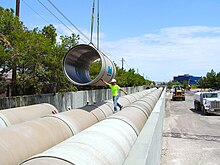Amiblu
| Amiblu Holding GmbH | |
|---|---|
| legal form | Company with limited liability |
| Seat |
Klagenfurt , Austria |
| management | Pierre Sommereijns |
| Branch | Construction supplier |
| Website | www.amiblu.com |
The Amiblu Holding GmbH , based in Klagenfurt is a manufacturer of glass-reinforced plastic pipes; The company emerged in 2017 from a merger of Hobas Europe (part of the Austrian conglomerate Wietersdorfer ) and Amiantit Europe (part of the Saudi Amiantit Group). Together with the headquarters in Klagenfurt, Amiblu operates production facilities in Germany, Spain, Poland and Romania and employs around 1,500 people. The research and development center in Norway is an officially accredited test laboratory for GRP pipes.
Products
The Amiblu Group's Hobas technology produces circular and non-circular (NC) pipes, molded parts , shafts, containers and accessories such as couplings made of glass fiber reinforced plastic (GRP) . The products are used as drinking water, sewage, irrigation and drainage pipes, as hydropower plant, protection and ventilation pipes; they are used in shaft construction, flood protection and in various industrial applications. The hurled Hobas pipes can be laid in open trenches, trenchless by tunneling or relining , above ground and in water (fresh or salt water).
Company history
In the 1950s, the Basel piece dyeing factory was looking for an alternative to the traditional dyeing of fabrics. Splintered and discolored wooden cylinders around which the fabrics were wrapped endangered the textiles. A centrifugal process was developed for GRP, which up to now has mainly been used in automobile, aircraft and shipbuilding. Due to its resistance to corrosion and chemicals , the material was ideally suited to the requirements. It was quickly recognized that the advantages could also be useful in other applications, such as transport for water. This is how the patent for centrifuged GRP pipe systems came about. In 1957, the Hobas company was founded in Basel, in 1977 the Wietersdorfer Group acquired the license for pipe production in Austria and from 1984 held a 50% stake in Hobas. Hobas has been fully owned by the Wietersdorfer Group since 2011.
In 2016 Wietersdorfer (owner of the Hobas Group) and Amiantit Europe announced the intention of merging their European activities. Amiblu was founded in 2017 and also sells Hobas product technology; the two shareholders each hold 50% of the newly founded Amiblu Group.
Hoba's centrifugal process and chemical composition
The products essentially consist of unsaturated polyester resins (UP), cut glass fibers (GF) and mineral reinforcing materials. The pipe is built in from the outside in a rotating die . After all the material has been introduced into the die, the speed of rotation is increased, whereby the raw materials are pressed, degassed, compressed and hardened against the die wall with an acceleration of up to 75 g (75 times the acceleration due to gravity ). This process makes it possible to design the wall thickness evenly with high longitudinal compressive strength . The three-dimensional chemical compound of the resin prevents deformation ( thermoset ).
Environmental awareness
As part of an environmental study published by Hobas in collaboration with the GSTT ( German Society for Trenchless Technology ) in May 2011, the CO 2 emissions from laying in open trenches were compared with those from driving. The results of the study show that for the Czajka-I project the trenchless laying of sewage pipes is a more climate-friendly solution than an open laying. Thanks to the choice of trenchless technology, a total of 376,734 tons of CO 2 or the annual CO 2 emissions of 104,430 cars could be saved. The emissions from production, transport, laying (tunneling or open laying) and traffic (diversions, traffic jams) were included.
literature
- Peter Grombach, Klaus Haberer, Gerhard Merkl, Ernst U. Trueb: Handbook of water supply technology . Oldenbourg Industrieverlag, 1999, ISBN 978-3-8356-6394-7 .
- GWE EXTRA 2008 - The anniversary issue of GWF Wasser / Abwasser and GWF Gas / Erdgas for the 75th anniversary of the Oldenbourg Verlag.
- Karl Pahl: Water Management - The importance of water management yesterday, today, tomorrow . Steffen Verlag, 2005, ISBN 3-937669-53-1 .
- Victor Vladimirov: "Comparison of CO 2 emissions with trenchless and open laying of jacking pipes D e 3000 for the Czajka project, Warsaw, Poland", in: GSTT - German Society for Trenchless Technology EV: "Information - Ecology and Economy", 1 2nd edition, Books on Demand GmbH, 2012, ISBN 978-3-8448-2075-1 .
Web links
Individual evidence
- ↑ a b c About us. In: Hobas. Retrieved May 20, 2019 .
- ↑ hobas.com , accessed on September 26, 2011.
- ↑ hobas.com , accessed on September 26, 2011.
- ↑ hobas.com , accessed November 29, 2011.
- ↑ Plastic News Europe: Hobas, Amiantit complete European merger , September 15, 2017 (English)
- ↑ hobas.com , accessed November 29, 2011.
- ↑ hobas.com , accessed November 29, 2011.
- ↑ Vladimirov, V (2011): Comparison of CO 2 emissions with trenchless and open laying of jacking pipes D e 3000 for the Czajka project, Warsaw, Poland, in: GSTT - German Society for Trenchless Technology EV: Informations - Ökologie und Ökonomie, 1st edition, Norderstedt.



